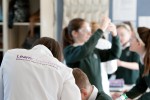Today sees the launch of the RSC
Visual Elements Periodic Table phase 2. This latest incarnation of the RSC periodic table now has an additional 5 tabs to explore! It covers the
history of the periodic table, the
alchemy that was practised in the Middle Ages, Chemistry World
podcasts,
videos, and
trends of the periodic table.
The history tab explains the development of the periodic table as well as the scientists that discovered the elements. I love the slide bar that shows the elements that had been discovered by any particular year!
The alchemy tab explains about the dark art of alchemy, the aims of which were three-fold:
-
To find the Stone of Knowledge;
-
To discover the medium of Eternal Youth and Health, and
-
To discover the transmutation of metals – that is turning things to gold.
The podcasts by
Chemistry World discuss the nature of each element, where they are found, what they are used for….more than you could ever need to know about the elements!
The videos come courtesy of The University of Nottingham’s very popular chemist, Professor Martyn Poliakoff, and Brady Haran. These now famous videos have had hundreds of thousands of views on YouTube and we can’t wait to share them with you here.
Last, but by no means least, is the trends tab. This shows visually, the trends of density, atomic radius and electronegativity across the periodic table (shown below).
At the RSC we enjoy both a celebration of each others' hard work, and cake, so what better way to celebrate the new additions to the periodic table than having cupcakes made for every element, coloured to match the visual elements periodic table and flavoured to match the blocks!
